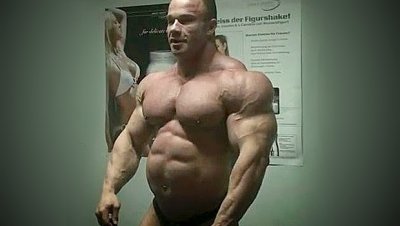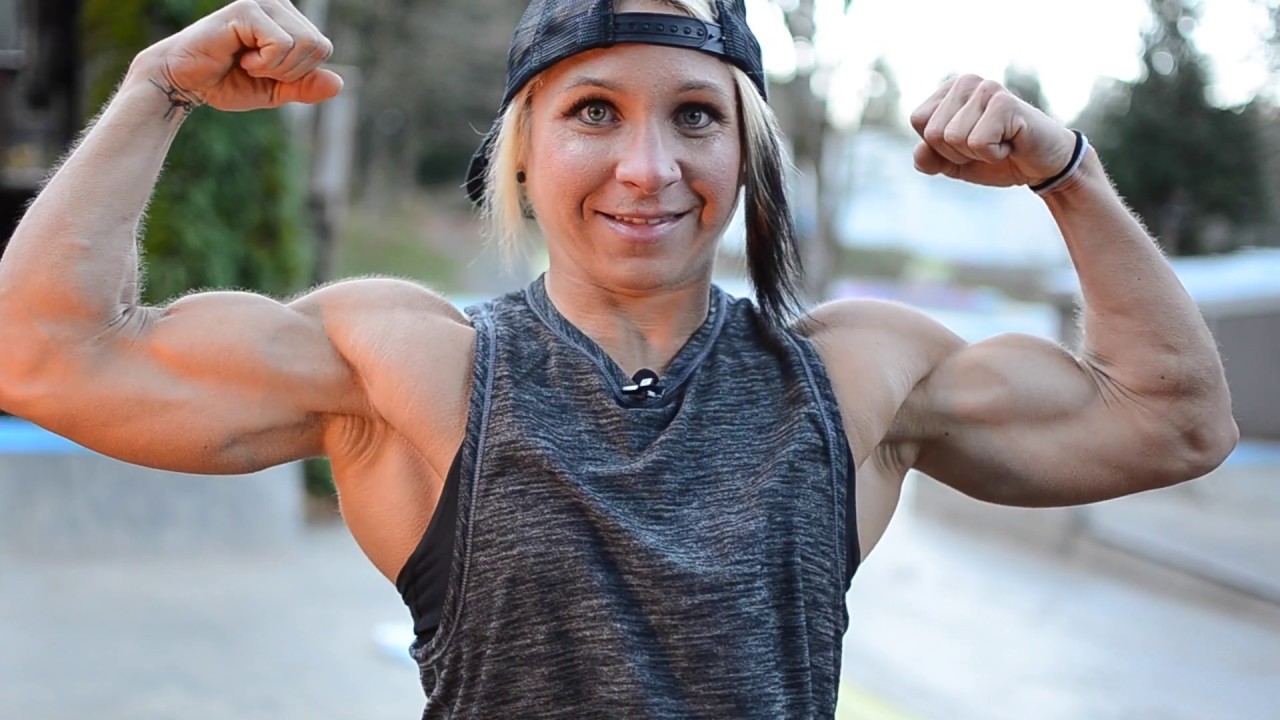Many are curious whether certain friends, family members or spouses are taking anabolic-androgenic steroids. However, due to legality issues, health concerns and social stigmas; many steroid-users do not want to disclose such details (even to loved ones).
However, they may not need them to admit to such, with there being numerous signs of steroid-use, that are observable from a person’s behaviour and appearance.
In this guide we reveal the top 15 ways to spot a steroid user, thus if someone ticks several of the boxes on this list, the chances are they are either: taking steroids, or have done so during their lifetime.
Note: this list does not guarantee 100% accuracy, which is only possible through random testing.
15 Signs of Steroid-Use
1. Flushed Skin
 Anabolic steroids cause LDL cholesterol levels to rise and HDL levels to plummet, causing hypertension to different degrees (depending on the compounds used).
Anabolic steroids cause LDL cholesterol levels to rise and HDL levels to plummet, causing hypertension to different degrees (depending on the compounds used).
One symptom of raised blood pressure is an increase in core body temperature.
When a person’s temperature rises, their skin can look flushed or take on a pink appearance.
This is a sign that someone is currently administering anabolic-androgenic steroids (AAS) on a cycle.
It is important to understand that some people naturally have a flushed appearance to their skin; however, if someone’s complexion has been altered; this can point to steroid use.
Note: There are other drugs and medications that can elevate systolic blood pressure, causing similar flushing, such as pre-workout supplements or stimulant-based fat burners.
2. Sudden Changes in Body Composition
If someone has suddenly blown up and gained 30lbs of muscle mass in the last few weeks, this is indicative of steroid use (particularly the use of bulking compounds).
Building muscle naturally is a very slow endeavor, that takes many years of hard work and discipline, in regards to training and nutrition.
If someone has built large amounts of muscle, whilst simultaneously getting leaner, this also indicates anabolic assistance.
This is because it is very difficult for natural bodybuilders to add muscle and burn fat simultaneously, due to a calorie surplus often needed to gain weight and a calorie deficit needed to lose weight.
Thus, you cannot be in a caloric surplus and deficit synchronously, which is why bodybuilders have two separate phases, known as bulking and cutting.
However, anabolic steroids, such as Anavar, Trenbolone, Testosterone or Winstrol, can make it very possible to add muscle and strip away fat concurrently.
However, it is important to note that when a person first starts lifting weights, it is normal for them to build significant amounts of muscle (20-30lbs), whilst simultaneously burning fat stores, as their body responds to this new stimulus.
Dramatic results among novice weight lifers are known as ‘newbie gains’ and mostly occur during the first couple of months of regular training.
If someone suddenly gains 20-30lbs of muscle but has been lifting weights for an extensive period of time; this is a sign of an enhanced athlete.
The most effective way to know if someone is taking steroids is to observe their ‘gains timeline’.
This involves compiling several pictures of the person throughout their life, to see when certain growth spurts occurred.
If someone experienced dramatic results when they first started lifting, plateaued afterward, then had another conspicuous growth spurt five years later; this points to steroid use.
However, if someone was exceptionally muscular during puberty, then started lifting weights and gained 20 pounds of muscle; then remaining (approximately) the same size afterward. This is indicative of strong genetic structure and not anabolic steroid use.
3. Roid Rage
Anabolic steroids increase serum testosterone levels to exceptionally high levels (exogenously).
Consequently, aggression is likely to increase, resulting in bursts of anger in some individuals.
The degree of anger is likely to depend on the person, however most steroid-users will notice themselves becoming less patient and more irritable with the people around them.
Unfortunately, this side effect may lead to hypomania or manic episodes, negatively affecting spouses.
One study even found that steroid-users were twice as likely to commit a weapon-related crime (1).
4. Disproportionate Muscle Groups
Research suggests that steroid-users who participate in weight training build significantly more hypertrophy (size) and strength, compared to steroid-users who are sedentary (2).
Therefore, if someone were to take steroids and not train certain muscles (such as their quadriceps); this could result in a more disproportionate body; compared to a natural weight lifter training in the same fashion.
In short, steroids cause extreme hypertrophy in trained muscle cells. Therefore, it is easier to become disproportionate, if certain muscle groups don’t receive the same level of volume as others.
Note: Disproportionately sized muscles can occur in natural athletes; however, the potential for unevenness is considerably greater when utilizing anabolic-androgenic steroids.
5. Hair Loss (Male Pattern Baldness)
Steroid use often damages hair follicles on the scalp, resulting in genetically sensitive individuals experiencing MPB (male pattern baldness) or alopecia.
This side effect is particularly common in highly androgenic steroids, such as Trenbolone, Anadrol and Testosterone.
High levels of androgens in the body, significantly elevate DHT (dihydrotestosterone) levels, causing hair follicle shrinkage. This can lead to thinning, recession or loss of hair on the scalp, whilst thickening and accelerating hair growth on the body.
Note: This side effect is largely influenced by a person’s genetics, thus a person could take steroids and not notice much hair loss (especially if androgenic steroids are avoided). However, on average, steroids will expedite the hair loss process for many individuals, causing increased recession or thinning.
6. Exceptional Deltoid/Trapezius Development
 The deltoids (shoulders) and trapezius muscles often experience the most growth when taking anabolic steroids.
The deltoids (shoulders) and trapezius muscles often experience the most growth when taking anabolic steroids.
This is because a higher number of androgen receptors are found in these muscles, causing them to be more susceptible to increased hypertrophy (size), when under the influence of androgenic compounds.
3D boulder shoulders and cobra-looking traps are often unattainable for a natural bodybuilder.
However, someone may be taking anabolic steroids and not have exceptionally well-developed deltoids or trapezius muscles; due to the specific compounds used.
For example, Arnold Schwarzenegger never displayed colossal hypertrophy in the deltoid/trapezius region; however, he was known to be taking less androgenic steroids, such as Dianabol (Methandrostenolone) and Deca Durabolin (Nandrolone).
The only logical explanation for why a natural bodybuilder would have excessively large deltoids/trapezius muscles is if their training reflected high volume for such muscles groups, in comparison to the rest of their body.
7. Acne
Acne vulgaris or seborrhea (oily skin) can be visual signs of steroid use and are particularly common when androgenic compounds are used (examples: Trenbolone, Testosterone, Anadrol).
Potent AAS can cause overactive sebaceous glands, stimulating excessive levels of sebum.
Sebum is a waxy matter, that in standard amounts acts as a healthy moisturizer to the hair and skin.
However, over secretion can result in blocked pores. In extreme cases, this can lead to cystic acne, where cysts the size of golf balls may form underneath the skin.
This side effect is more linked to genetics; however, if someone is known to have oily skin, this is likely to worsen when taking steroids.
8. Difficulty Urinating
Androgenic steroids can cause benign prostatic hyperplasia (enlargement of the prostate gland).
This can lead to blocked urinary flow, making it more difficult for men to empty their bladder.
This side effect is what inspired Dr. John Bosley Ziegler to design a compound that would be more anabolic than Testosterone, yet less androgenic; as it was known that Soviet athletes were using catheters (consequent of their Testosterone use).
Dr. Ziegler succeeded in his mission, formulating Methandrostenolone, known today as Dianabol.
9. Gynecomastia

Gynecomastia is essentially enlargement or swelling of breast tissue in men. This occurs due to hormone imbalance; specifically estrogen dominance.
Many anabolic steroids have the aromatase enzyme present, which is responsible for converting testosterone into estrogen (the female sex hormone).
Consequently, a man may develop puffy nipples or female-looking breasts, requiring an anti-estrogen medication to reduce swelling, or surgery to remove glandular tissue and excess fat.
Bodybuilders often have protocols in place to prevent gynecomastia from occurring, such as running an AI (aromatase inhibitor), being Anastrozole (Arimidex) or Letrozole (Femara). Such medications prevent the conversion from testosterone to estrogen.
Also SERMs (selective estrogen receptor modulators) may be taken, such as Tamoxifen (Nolvadex) during a cycle, to block estrogen-like effects directly in the breast tissue receptors. SERMs are more optimal than taking AI’s, in relation to cardiovascular health, with SERMs having no adverse effects on blood lipids (3).
Steroid-users may also opt for less estrogenic steroids, in an attempt to avoid this visually unpleasant side effect.
Some examples of highly estrogenic steroids are Anadrol, Dianabol and Testosterone.
Some examples of anabolic steroids that fail to aromatize (and convert to estrogen) are Trenbolone, Anavar and Winstrol.
10. Water Retention/Bloating
Further implications of estrogenic steroids are water retention and bloating.
Estrogen increases osmotic sensitivity (4) and sodium retention, due to fluctuations in aldosterone (5); thus causing extracellular fluid to accumulate (outside the muscle cells).
This contributes to a decrease in muscle tone and higher incidents of bloating in users, with the extent of which depending on the dosage.
Many weight lifters and bodybuilders administer significantly higher dosages of AAS today, compared to those in previous generations, resulting in bigger waistlines and puffier physiques.
Steroid-induced water retention can also cause extremely full and even 3D-looking muscles. This is due to increased glycogen uptake inside the muscle cells, causing exceptional thickness and a constant pumped look.
11. Increased Visceral Body Fat

Steroid-users can be lean, yet have a bloated or fat-looking stomach.
This isn’t always attributed to water retention, but instead higher levels of visceral fat (VF).
Visceral fat is adipose tissue that accumulates around vital organs, such as the liver and intestines. This type of fat isn’t visible to the naked eye (unlike subcutaneous fat); however, it can cause the abdomen to have a protruding appearance.
High levels of VF are associated with increased health risks, such as cardiovascular disease and type II diabetes.
One study measured the body fat percentage of ex-steroid users and found them to have less fat mass (on average), compared to non-steroid-users (3).
However, the steroid-user group had higher levels of visceral fat, compared to males who had never taken AAS.
This increase in visceral fat is due to impaired insulin sensitivity, caused by anabolic steroids, which can prolong for several years after steroid cessation.
In contrast, natural bodybuilders can display very tiny waists at low levels of body fat, with no distension or bloating (from the midsection).
Although many anabolic steroids increase visceral fat, there is evidence to suggest certain steroids may reduce VF; at least in the case of Anavar (Oxandrolone).
In one study they found Anavar-use not only resulted in less subcutaneous fat, but also less visceral fat; compared to Testosterone (4). This may be linked to Anavar improving insulin sensitivity, rather than worsening it (5,6).
12. Virilization in Women

If women use highly androgenic steroids, they may experience virilization effects, otherwise known as masculinization.
Such adverse effects include:
- Irregular menstrual cycles
- Clitoral enlargement
- Breast reduction
- Hair growth (on the body)
- Hair loss (on the scalp)
- More pronounced jawline
- Adam’s apple (laryngeal prominence)
There are however some female-friendly steroids that have a low virilization risk, such as Anavar and Primobolan. However, if high dosages are utilized or cycles become excessive, the above effects are still possible.
13. Erectile Dysfunction
Erection quality is likely to increase when taking steroids, due to large spikes in exogenous testosterone and nitric oxide production. However, as a steroid cycle reaches its latter stages and eventually ceases; ED is a common side effect, due to the shutting down of endogenous (natural) testosterone.
This can even occur in the initial stages of a cycle with some compounds, such as Deca Durabolin (nandrolone).
Nandrolone-induced erectile dysfunction, or ‘Deca dick’, as referred to in the bodybuilding community, is caused by the elevation of prolactin levels. High amounts of prolactin can have a negative effect on libido and sexual desire/enjoyment (7).
14. Increased Alpha Male Behaviour
High testosterone levels are associated with alpha male behaviour, thus when someone takes steroids they are more likely to express dominance, confidence and assertiveness.
This may be more easily observable in introverted or shy individuals, who may now come out of their shells.
Alternatively, individuals who are already confident may become more so; due to even higher levels of serum testosterone.
However, this effect may only be short-lived, as testosterone levels crash post-cycle; leaving a person with low T levels for several weeks or months following.
Such fluctuations in this male hormone can contribute to steroid addiction/dependence; as much from a psychological perspective, than a physiological one.
Testosterone plays a crucial role in well-being, thus steroid-users often report feeling euphoria, caused by high levels of dopamine.
Thus, steroid abuse (albeit related to physical fitness), is similar to other drug-use; in the sense that it triggers ‘reward’ neurotransmitters in the brain.
15. Dry Looking Muscles

Many steroids contribute to fluid retention; however, some AAS have diuretic effects, giving a dry look to the muscles; with veins and muscle striations becoming more visible.
Winstrol and Anavar are two steroids that expel extracellular fluid, resulting in a vast and rapid improvement in muscle definition.
Such low levels of water retention, can look artificial and almost as if a bodybuilder has been photoshopped.
Thus, depending on what steroid is used, individuals may experience a smooth/bloated appearance, or an overly dry/ripped one.
Summary
Research suggests 3-4 million people use anabolic-androgenic steroids in America (8), with over 1 million people in the UK also taking them regularly for cosmetic purposes (9).
It is important to remember that if someone has big muscles, or is in good shape, it doesn’t necessarily mean they are taking steroids (or have taken them). Genetics is arguably a more overriding factor in affecting body composition, than taking AAS.
The various signs of steroid use listed in this article are a more accurate method in identifying potential steroid-users, than merely judging by the size of someone’s muscles.
However, there certainly will be a threshold in regards to the maximum amount of lean muscle a human can carry (without the use of anabolic steroids).
